DNA and Data: The Currencies of Modern Eugenics

Jesse Smith | TruthUnmuted.org
The year is 2052. No humans are born without first undergoing mandatory genetic screening. Tristan, a 27-year-old robotics engineer, has just been apprehended by the Federal Precrime Agency (FPA). After sitting alone for hours in a dark cell, he finally learns the reason for his detention. It turns out that his DNA samples (taken at birth) were matched to a distant relative who ran afoul of the government for protesting, spreading misinformation, and using a deep-faked identity to access the Metanet. The FPA agent informs Tristan that all his family members are also in custody and presumed guilty since “domestic terrorist” genes tend to run in the family. One by one, each family member appears before an AI-powered robot judge who sentences them to life in prison. With no opportunity to appeal the decision, they are shipped around the country to serve time in reeducation facilities. If they agree to be implanted with a brain computer interface, they’ll be granted entry into a minimum-security facility to serve as mind conduits for advanced AI algorithms and machines. If they reject the implant and rehabilitation fails, a maximum-security cell in a low orbit satellite awaits, where their vitality is harvested to power the green energy grid.
Not even Philip K. Dick on speed could fully envision the nightmare scenario described above. What’s even more alarming is how quickly it could happen (well, at least the Federal Precrime Agency and mandatory genetic screening).
In a recent interview on Wired, Noor Siddiqui, CEO of Orchid, reveals her attempt at advancing the field of genetic testing for parents desiring children (while offering reassurances that this is not an attempt at modern eugenics). Orchid is one of the first companies performing whole genome sequencing on embryos using small samples of DNA. Orchid’s services are already being used by several unnamed Big Tech gurus and at $2500 per embryo, the service isn’t cheap. Orchid screens for monogenic conditions such as neurodevelopmental disorders, pediatric and adult-onset cancers, birth defects, and chromosomal abnormalities. It also offers genetic predisposition screening for brain health, heart health, and other general issues.
Siddiqui’s intentions seem compassionate and even noble. Her motivation for launching Orchid partly stemmed from watching her mother suffer from legal blindness. She wants future parents, including herself, to avoid seeing their children suffer from the multitude of maladies plaguing humanity. She believes Orchid’s screening services will relieve parental anxieties and lead to a population increase. What’s odd is that she doesn’t seem to consider the alternative – parents forgoing child rearing because of the risks discovered through the company’s genomic sequencing.
Siddiqui’s background as a Thiel Fellow and ties to the current roster of Orchid investors is alarming. Peter Thiel, a Silicon Valley icon, billionaire venture capitalist, and futurist with transhuman leanings is partly responsible for the creation of successful companies such as PayPal and Palantir. He helped Facebook become a household name through his early investment and position on its board of directors. Through his Founders Fund firm, Thiel was an early bitcoin purchaser and investor in industry giants such as Airbnb, LinkedIn, Yelp, Spotify, Clearview AI, OpenAI, Neuralink, and SpaceX.
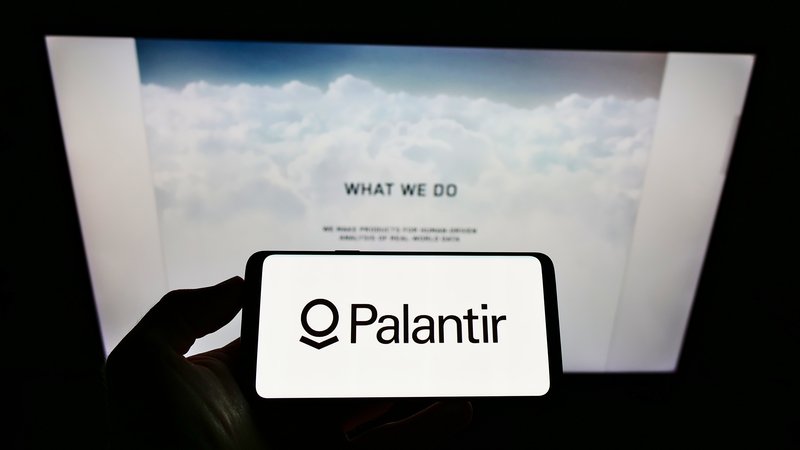
Palantir, one of the world’s largest data mining firms, was created by Thiel in 2003. It was launched shortly after DARPA (the most powerful military R&D agency in the world) scrapped its plans to create the Total Information Awareness (TIA) program which was vehemently opposed by the public. Palantir’s technology is used for mass surveillance and data collection. The company was funded through In-Q-Tel, the CIA’s venture capital firm, and has deep ties to the intelligence community and military-industrial complex. Palantir’s Gotham software gathers enormous amounts of personal data and aids law enforcement in analyzing the lives of suspects without obtaining warrants. Palantir also ventured into the field of public health surveillance by partnering with the U.S. Department of Health and Human Services (HHS) in 2020 to build Tiberius, a software platform that tracks vaccine production, distribution, and administration. Palantir also built the CDC web app for monitoring the spread of COVID-19.
The Thiel Fellowship offers young people under age 22 a $100,000 grant to skip or drop out of college. Investments are heavily weighted toward ventures supporting Thiel’s vision of “technology as salvation” such as:
- Artificial Intelligence and Robotics
- Biotechnology
- Blockchain
- Cryptocurrency
- Health and fitness tracking
- Lifespan extension (longevity, age)
- Healthspan extension (quality of life)
- Self-driving cars (IoT)
The 2024 class zeroes in on futuristic tech including AI-powered:
- Infrastructure creating a global labor market facilitating evaluations of all persons (Mercor)
- Surveillance to gather precise data for the visible fruit on any tree (Orchard Robotics)
- Language models (Automorphic)
- Computer chips (Etched)
- Consumer financial data profiles (Hyperplane)
- Computer that operates and connects all devices (Explore Interfaces)
- Autonomous, super-intelligent financial analyst (Endex)
- Software engineering platform (Cognition AI)
Other awardees included Januus, a company that maps the physical location of cryptowallets and people on a global scale, and Rainmaker, a cloudseeding company seeking to use high performance drones to modify the weather.
Thiel’s influence on modern technological developments is immense, to say the least. Though it doesn’t appear Siddiqui’s Orchid has any direct connections to Thiel, its purpose fits within his goals of lifespan extension and control of human genetics, as Thiel is also an investor in CRISPR research
A closer look at the company’s other investors reveals some curious ties. One of Orchid’s main financiers is Anne Wojcicki, CEO of 23andMe, former spouse of Google co-founder Sergei Brin, and sister to former YouTube CEO and censorship queen, Susan Wojcicki.
23andMe does for adults what Orchid strives to do for the unborn, though not without major concerns. As I wrote in a previous article:
…at an Aspen Institute Security Forum, Jason Crow, a U.S. representative from Colorado and member of the House Intelligence and Armed Services Committees warned that DNA provided to companies such as 23andMe and Ancestry could be used to create bioweapons targeting specific individuals. The DNA obtained by these companies is innocently shared by customers expecting to receive reports that detail conditions of their health and/or genetic lineage, but could be used without their knowledge or consent for nefarious purposes.”
Citing these safety concerns, the Pentagon warned military personnel not to use DNA services from Ancestry and 23andMe.
The goal of 23andMe is to obtain customer DNA and – in turn – sell it to the highest bidders to fuel research. Underpinning this vision, Wojcicki herself once said, “We set out with this company to revolutionize health care.” In a Scientific American article, 23andMe board member Patrick Chung disclosed a secret about the company’s business model, stating:
The long game here is not to make money selling kits, although the kits are essential to get the base level data…Once you have the data, [the company] does actually become the Google of personalized health care.”
The same article warned that:
…23andMe’s Personal Genome Service is much more than a medical device; it is a one-way portal into a world where corporations have access to the innermost contents of your cells and where insurers and pharmaceutical firms and marketers might know more about your body than you know yourself.”
23andMe assures its customers that their data won’t be sold to third parties without consent. However, they do sell “anonymized” genetic data to pharmaceutical and other companies. Despite this precaution, it suffered a massive security breach last October where data from 14,000 user accounts and over 6 million associated profiles was stolen. Regarding the incident, the Electronic Frontier Foundation warned:
Genetic information is an important tool in testing for disease markers and researching family history, but there are no federal laws that clearly protect users of online genetic testing sites like 23andMe and Ancestry.com. The ability to research family history and disease risk shouldn’t carry the risk that our data will be accessible in data breaches, through scraped accounts, by law enforcement, insurers, or in other ways we can’t foresee.”
Orchid’s entanglement with Wojcicki and 23andMe doesn’t inspire confidence that it can avoid the same pitfalls, as its customer data policies are very similar. Orchid readily admits to disclosing its clients “de-identified genetic information to public databases in order to advance medical research.” With client consent, it also uses the de-identified genetic data in collaboration with third parties such as “universities, hospitals, health systems, government institutions, or private companies…”
Though Orchid encrypts personal genetic data, it does not offer any guarantees it will not be “accessed, disclosed, altered, or destroyed” by a breach of its physical, technical, or managerial safeguards. In other words, sharing data with the company is at your own risk. Whether the data is “anonymized” or “de-identified” may not matter one iota if the company’s security mechanisms are compromised.
While Siddiqui may be relatively unknown, Orchid is backed by several other heavyweights in finance, science, and Big Tech. The complete list of investors invokes even greater unease, including:
- Carlos Bustamante, a Harvard alum, biologist, and co-founder of Galatea Bio, the company that determined Senator Elizabeth Warren had Native American ancestry from DNA test results.
- George Church, a renowned geneticist, MIT and Harvard professor, and entrepreneur who helped initiate the Human Genome Project in 1984 and the Personal Genome Project in 2005.
- Vitalik Buterin, a computer programmer, former Thiel Fellow, and codeveloper of the Ethereum blockchain cryptocurrency.
- Elad Gil, an entrepreneur, investor, former Google employee, VP at Twitter (now X), and AI enthusiast.
- Brian Armstrong, a billionaire CEO of cryptocurrency exchange Coinbase and co-founder of NewLimit, a company seeking to radically extend human health span using epigenetic reprogramming.
Transhumanism, 4IR and Convergence
But of all the myths the Technocrats peddle, none is more far-fetched than transhumanism, a concept dear to the heart of Peter Thiel. And to understand what could well be the Biggest Lie of Big Tech requires a deep dive into this social movement, which is focused on R&D for “human-enhancement technologies” that might someday allow people to live to the age of 160 or more…”
– Jonathan Taplin, How Musk, Thiel, Zuckerberg, and Andreessen—Four Billionaire Techno-Oligarchs—Are Creating an Alternate, Autocratic Reality
Orchid’s investors bring together blockchain, cryptocurrency, AI, genetics, and biotechnology, positioning the company at the intersection of transhumanism and the Fourth Industrial Revolution (4IR). To fully comprehend what both movements intend for humanity requires a look at their core philosophies, starting with The Transhumanist Manifesto. Though originally written in 1998, the current version penned by Natasha Vita-More, Executive Director of Humanity+, life extension proponent, and spouse of transhuman apostle Max More, proclaims that:
The Transhumanist Manifesto challenges the human condition. This condition asserts that aging is a disease, augmentation and enhancement to the human body and brain are essential to prevail, and that well-being is essential to prosper within safe and healthy environments…
The aim is to mitigate aging and extend life beyond the maximum lifespan… Genomics has made it possible to predict, diagnose, and treat diseases with more precision and focused on personalized care…” (emphasis added)
Parroting this line of thought, World Economic Forum founder Klaus Schwab summarized the Fourth Industrial Revolution as being “characterized by a range of new technologies that are fusing the physical, digital and biological worlds, impacting all disciplines, economies and industries, and even challenging ideas about what it means to be human.” In his book Shaping the Future of the Fourth Industrial Revolution, Schwab further defines this societal transformation, writing:
The future will challenge our understanding of what it means to be human, from both a biological and a social standpoint. Emerging biotechnology agendas promise to improve and augment human lifespans and to enhance physical and mental health.”
A third concept within this agenda is the movement toward convergent technologies. The ideas were first described in the 2002 Converging Technologies for Improving Human Performance report as the synergistic combination of four major areas of science and technology, including nano-bio-info-cogno or “NBIC”. To clarify, NBIC is the merging of:
- nanoscience and nanotechnology;
- biotechnology and biomedicine, including genetic engineering;
- information technology, including advanced computing and communications; and
- cognitive science, including cognitive neuroscience.
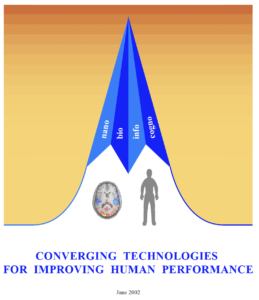
The report was produced by the U.S. National Science Foundation (NSF) and Department of Commerce (DOC). It was composed of submissions gathered for a 2001 workshop attended by scientific leaders and policy makers. The lengthy report featured a myriad of topics and was broken into six main sections, including:
- overall potential of converging technologies
- expanding human cognition and communication
- improving human health and physical capabilities
- enhancing group and societal outcomes
- national security
- unifying science and education
If you ever wondered where Elon Musk got the idea for Neuralink, or how Mark Zuckerberg envisaged Facebook and the Metaverse, or why Sam Altman became interested in artificial general intelligence (AGI), the answers may lie within this report.
The 2013 multiagency follow-up report Beyond Convergence of Nano-Bio-Info-Cognitive Technologies focused on finding solutions to key societal challenges and presented “convergence of knowledge and technology for the benefit of society (CKTS)” as the core means of 21st century progress. A key theme was “improving lifelong wellness and human potential, including advancing a cognitive society, achieving individualized and integrated healthcare and education…”
In Exploring Biodigital Convergence, a 2019 Policy Horizons Canada report, director general and former World Economic Forum head of strategic foresight Kristel Van Der Elst wrote:
In the coming years, biodigital technologies could be woven into our lives in the way that digital technologies are now. Biological and digital systems are converging, and could change the way we work, live, and even evolve as a species. More than a technological change, this biodigital convergence may transform the way we understand ourselves and cause us to redefine what we consider human or natural.”
Whether you agree or not, the world is rapidly being pushed toward the fusion of technology and biology while challenging the Christian view that man is made in the image of God or “Imago Dei.” Anyone suggesting this scenario is naturally evolving is both disingenuous and deceptive. Peter Thiel, Klaus Schwab, and Natasha Vita-More are not sitting idly by watching this transformation take place. They are all active participants, piloting the convergence mothership alongside others in the scientific, medical, financial, and tech communities. With grandiose visions of a utopian future, convergence is a dangerous agenda with the potential for disastrous consequences.
Prophets and Profits of Precision Medicine
Precision Medicine is a burgeoning healthcare strategy utilizing genetic data to analyze and predict disease. It focuses on creating personalized treatments instead of a “one-size-fits-all” approach. According to Global Market Insights, the precision medicine market exceeded $52 billion in 2020 and is projected to reach $112 billion by 2027.
Launched by the Obama administration in 2016, the Precision Medicine Initiative married together Big Tech and Big Pharma along with a vast network of universities, government agencies, financiers, NGOs, and other experts. Whether officially stated or not, precision medicine’s driving force is the transhuman goal of life extension. It’s also the realization of Anne Wojcicki’s “revolution of healthcare” where drugs and therapies are tailored to the needs of individuals based on genetic makeup.
Big Pharma and biotech companies are poised to rake in huge profits from this sea change in medicine. Companies like Fractyl Health are already developing a gene therapy alternative to drugs like Ozempic and Wegovy to control blood sugar and weight. According to Wired,
The company wants to deliver an artificial gene to the pancreas that continuously produces the GLP-1 hormone so there’s no need for weekly injections. The approach, called gene therapy, uses inactivated viruses to carry a therapeutic gene to pancreatic cells.”
If this approach sounds familiar, perhaps it’s reminiscent of what mRNA technology (which Moderna admits is a gene therapy) inside of COVID-19 “vaccines” was supposed to accomplish. The results were horrifying to say the least, but medicine as we’ve known for the past century is heading toward obsolescence.
Aiding precision medicine is a megatrend called bioconvergence, which pharmaceutical giant Merck describes as a multidisciplinary approach that “harnesses a diverse mix of experts, processes, and technologies across biotech, software, and engineering.” Scores of new companies are taking advantage of this trend including the HLTH.Network, co-founded by Orchid investor George Church along with partners Dr. Axel Schumacher and Gourish Singla.
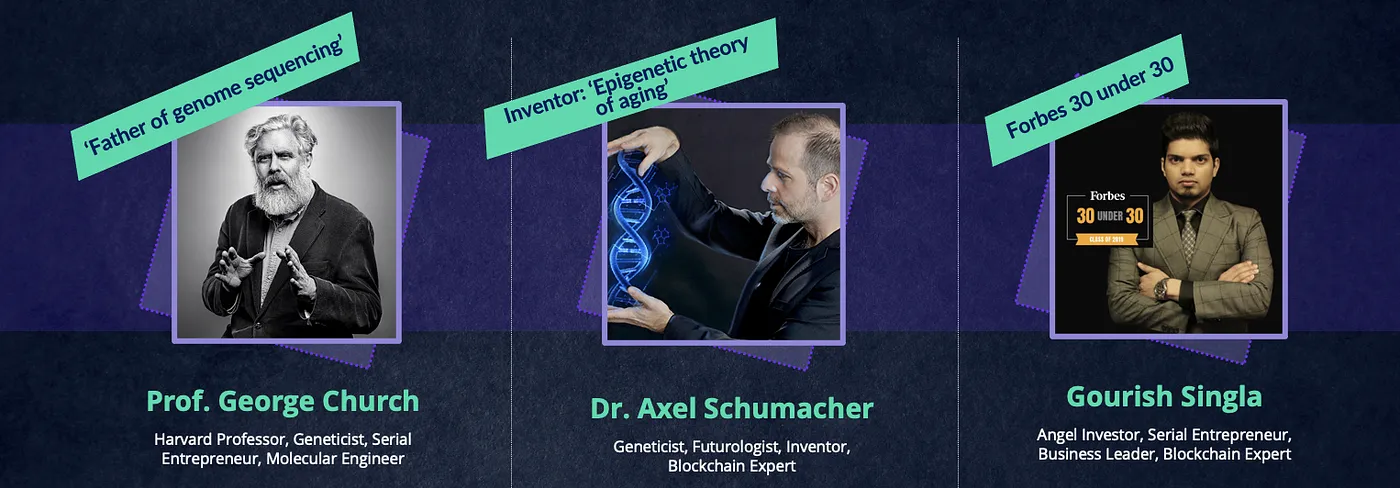
First launched under the name Shivom in 2017 and later rebranded the HLTH.Network, the company was established as a blockchain-powered, tokenized storehouse offering DNA data, a DNA NFT marketplace, and a “run to earn” healthcare app (though this seems to have been phased out along with other initial offerings).
While ushering in a “new era of precision medicine to uplift all humanity,” Church has positioned the company as the Palantir of global health data by providing secure access to research, genetic, and pharmaceutical data for use by biobanks, universities, pharmaceutical companies, and direct-to-consumer genetics companies like 23andMe.
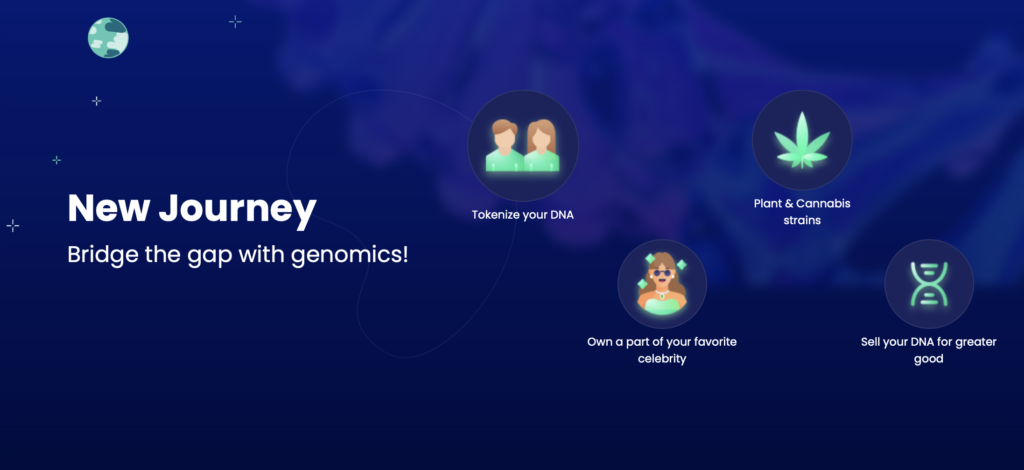
In addition to the HLTH.network, both Church and Schumacher are involved with companies working to combat aging and increase lifespans. Church co-founded Rejuvenate Bio, which uses gene therapy to increase lifespans in humans and animals. Schumacher is now the Chief Biotechnology Officer at the similarly named Rejuve.Bio, which employs AI-powered breakthrough therapies to combat aging and extend healthspan. A company whitepaper further elucidates its vision, stating:
At Rejuve.Bio, we challenge the age-old narrative that aging is inevitable…With precision medicine, we’re revolutionizing anti-aging. Instead of generic treatments, our mission is to design therapies tailored to people’s unique biology. How? By harnessing AI to integrate genetic, microbiome, biomarker, and clinical data. This allows us to devise custom regimens of drugs, diet, and lifestyle changes aimed not just at delaying aging, but preventing disease… AI isn’t just the latest tech buzzword; it’s a real game-changer in the world of medical discoveries. It is ushering in an age of rapid discoveries and unprecedented innovations, especially in diagnostics, drug development, and new treatments.”
Rejuve.Bio’s partner company is Rejuve.AI. It encourages customers to exchange personal health data for discounts on travel, supplements, medical tests, longevity therapies, and other benefits through its Longevity app. This information is then shared with Rejuve.Bio with the hopes of using it to pioneer experimental therapies. The company’s advanced AI tools harness massive troves of medical and biological data fed to it by individuals, health professionals, clinics, and other organizations.
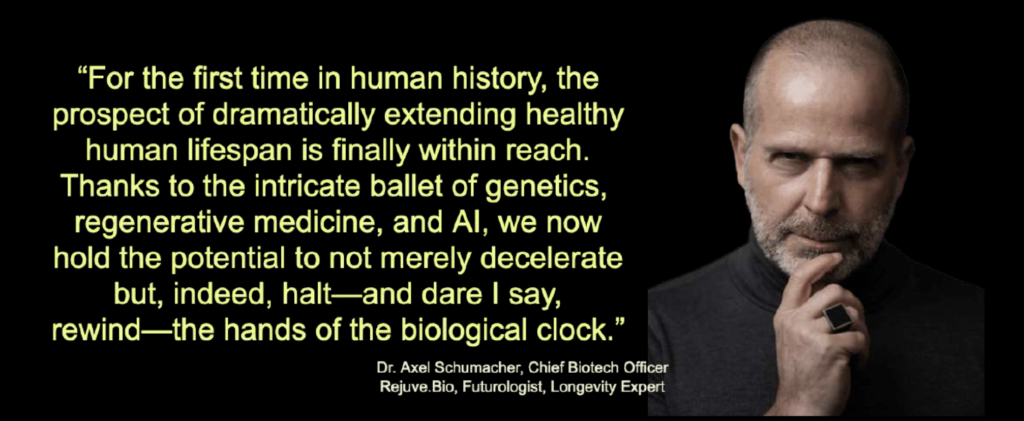
The Infrastructure for Modern Eugenics is Now in Place
“The open-ended character of modern natural science suggests that biotechnology will soon give us tools to allow us to accomplish what social engineers of the past failed to do. We shall then have definitively finished human history, because we shall have abolished human beings as such. And then a new, post-human history will begin.”
– Francis Fukuyama
The transhuman goals of life extension and unleashing human potential are not just affecting those voluntarily seeking these ambitions. Transhumanism – complete with its legion of accompanying technology – is advancing toward posthumanism where humanity reaches the next stage of evolution through some form of augmentation. Proponents are convinced that whether it’s through brain machine interfaces, DNA manipulation, bodily implants, or by combining all these measures and more, “Humanity 2.0” or “Singularity” will be reached. The question is will everyone participate in this grand experiment willingly or will it eventually be required by force?
Today, Orchid provides a service for those with both the money and desire to screen their unborn children for genetic defects. Tomorrow, Orchid’s services could be required to ensure that undesirables threatening to burden the global health system never take their first breath. Understandably, Siddiqui preferred to steer clear of any mention connecting Orchid to “Nazi” eugenics during the Wired interview. However, her company is but one small cog in a gigantic wheel barreling down a path toward a dystopian future. Her altruistic assurances are welcomed, but control of the DNA data driven beast that’s been unleashed does not rest entirely in her hands. Healthcare has been transformed into a giant public-private partnership (PPP) fueled by transhuman beliefs, venture capitalism, and converging technologies.
Looking past the utopian dreams of preventing disease and reversing aging, serious questions must be asked, including:
- In the future, will genomic sequencing be mandated to have children?
- Could parents be required to terminate pregnancies due to too many detected risk factors?
- Could Orchid and its competitors eventually become gatekeepers deciding which children are allowed to be born?
- Could genomic sequencing of embryos lead to the rise of genetically modified designer babies?
- Will the cost of these services create a caste system where only the wealthy are allowed to procreate?
- What happens to children born with a spotless genomic record who later develop conditions that went undetected as embryos?
- Will those born with “defects” be allowed to live their lives free from pressure to be treated, modified, or coerced into suicide?
The promises of those coveting human DNA for use in revolutionizing healthcare are shaped almost exclusively by those excluding the Christian worldview. Seeing themselves as gods, they have no qualms about reengineering their own bodies and tilting societal norms in their favor. Their belief in the concept of morphological freedom, where bodily modification is strictly voluntary and should never be coerced, offers some insurance against those with nefarious intentions. However, Jacob Shatzer reveals the faulty logic within the premise, writing:
“Morphological freedom is a formal necessity for transhumanism, but it is also a Trojan horse of sorts, carrying inside of it a corrosive logic that leads to self-transformation being the only conceivable choice…Morphological freedom as a right does not ensure the avoidance of coercion that transhumanists claim.”
– Jacob Shatzer, Transhumanism and the Image of God (pp. 63, 66). InterVarsity Press. Kindle Edition.
Data is king in the world envisioned by Thiel, Wojcicki, and Church. Human DNA and personal data are increasingly utilized as currencies fueling the biotech, genetics, biometrics, and finance industries. As conventional medicine is gradually replaced by many of the technologies previously covered, there may be little recourse for those wanting to opt out.
The more our DNA and data are used to develop drugs and treatments that theoretically improve health, the more people will willingly share biological and personal information without reservation. In this way, we are gradually being conditioned to accept parts of the transhuman agenda though we may outright reject other aspects. However, as technologies continue to converge, even those segments we reject may become just as irresistible if the benefits seem to outweigh the risks. Given time this becomes even more problematic since today’s youth have far less concerns about data privacy than previous generations. When considering how younger generations have been saturated with modern technology since birth, resistance may be extremely rare in perhaps another decade or two.
Do the Ends Justify the Means?
The idea that human nature includes a desire to change is not a strong enough foundation for the claims transhumanists make. The question is not only whether a desire to improve is part of human nature. The question is how sin affects this desire, and where the hope for change ultimately comes from.”
– Shatzer, Jacob. Transhumanism and the Image of God (pp. 65). InterVarsity Press. Kindle Edition.
Improving human health is a worthy endeavor, but the transhuman desire to redefine humanity is not entirely fueled by nobility or altruism. Beneath the surface of this honorable façade lies sinful motivations. In this instance, I’m referring to sin as a state of being, not an action or set of actions. Put simply, sin is separation, independence, and alienation from God. While in this state it is often difficult to ascertain one’s true worth, dignity, and purpose. So these attributes are sought outside of a relationship with our Creator. When lacking peace and communion with God, this state of isolation fuels pride and the unending quest for knowledge. To the transhumanist, sickness and death are technical problems to be solved, not consequences of sinful separation.
Our independence, coupled with beliefs in evolution and self-determination, have led to the monumental shifts placing biodigital convergence at the center of humanity’s hopes and dreams. It has become a de-facto religion where its pervasive technology is affecting every area of human existence.
Are the prophets of precision medicine uplifting all humanity or simply perpetuating our alienation from God? In the future, will those refusing bodily enhancement be viewed as second class citizens and denied human rights? Will the transhumanist maxim that augmentation is essential to prevail mean those who don’t are bound to lose? Is converging technology leading to our salvation or cementing our doom? Will the Peter Thiel’s of the world ever realize that just because something can be done does not mean that it should be done?
Finally, I leave with a warning previously issued in TransDEhumanization: Destroying Human Dignity:
This clash of ideologies is playing out on the world stage, with those in power forcefully imposing their worldview on those who hold to traditional religious beliefs and scientific facts about biology and nature. This effort to redefine humanity is nothing less than an attempt to dehumanize and detach us from the divine. If we accept that we are nothing more than random biological circuitry, then there is absolutely no reason for the elitist cabal to uphold human dignity or human rights (except for themselves, of course).”
Image: Source
Original Article: https://truthunmuted.org/dna-and-data-currencies-of-modern-eugenics/

Comments ()